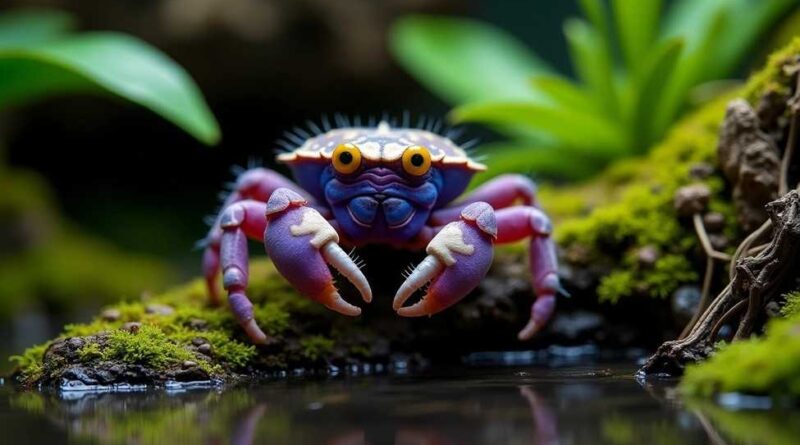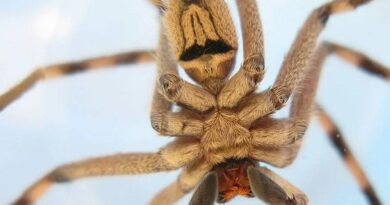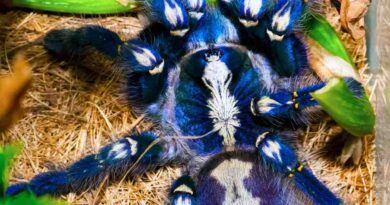Vampire Crab Care: The Beginner’s Guide You Actually Need [2025]
vampire crab care is surprisingly easy to care for, Despite their unique appearance. With their vibrant purple bodies, striking yellow eyes, and compact size of just 1.5 to 2 inches, these semi-terrestrial crabs make fascinating pets that don’t demand excessive maintenance.
Originally from Java, Indonesia, vampire crabs require a specific habitat setup with approximately 80% land and 20% water. While setting up their enclosure, we recommend a minimum tank size of 5 gallons for three crabs, maintaining humidity levels of 75% or higher. Additionally, these nocturnal creatures have particular dietary needs as omnivorous scavengers, consuming everything from insects to plant matter. In fact, with proper care, your vampire crab can live 2 to 2.5 years, with some reaching up to 4 years in captivity.
In this complete guide, I’ll walk you through everything you need to know about vampire crab care, from setting up the perfect habitat to understanding their diet, social behaviors, and long-term health requirements.
Understanding Vampire Crabs
The mysterious world of vampire crabs began unfolding for hobbyists around 2006 when these colorful crustaceans were . Before then, these captivating creatures existed in pet stores, but their origins remained largely unknown. officially “discovered” in the aquarium trade
Where vampire crabs come from
Vampire crabs belong to the genus Geosesarma, which includes semi-terrestrial crabs widely distributed across Southeast Asia, particularly Indonesia. Through careful detective work, scientists traced these crabs back to their native habitats on the island of Java, Indonesia. Furthermore, they’ve been found in surrounding areas including Sulawesi, Riau, and Krakatau islands.
These crabs aren’t purely aquatic dwellers – they’re semi-terrestrial creatures that live near freshwater rivers, streams, and ponds, often hiding among leaf litter and vegetation in forested areas. Unlike many crabs, they don’t depend on saltwater for development, instead thriving in humid forest environments with dense vegetation and rocky terrain.
Common species in the pet trade
Currently, there are 75 officially described Geosesarma, though only a handful commonly appear in the pet trade. The two most popular varieties are: species
- The iconic purple body and yellow eyes are characteristics of the bi-colored vampire crab (Geosesarma dennerle).
- Red Devil Crab (Geosesarma hagen) – Displays dark brown and bright orange coloration
Interestingly, both species were named after companies that supported research in Java – Dennerle and Rolf C. Hagen. Other species occasionally available include Geosesarma bicolor, Geosesarma noduliferum, and several undescribed species referred to by their common names like “Banana,” “Cream,” and “Orchid”.
Most vampire crabs reach approximately 2 inches in size including their leg span, making them perfect for smaller specialized habitats.
How long do vampire crabs live
The typical vampire crab lifespan ranges from 2 to 2.5 years both in captivity and the wild. However, certain species like Geosesarma tiomanicum (Disco) have reportedly lived over 4 years with proper care. Their relatively short lifespan is notably influenced by habitat conditions – poor environment management can significantly reduce how long they live.
Since these crabs practice direct development (their eggs hatch into very advanced juveniles rather than larvae), many species have extremely restricted natural distributions. This specialized breeding pattern explains why different species can sometimes be found just 10 kilometers apart in the wild.
Setting Up the Ideal Habitat
Creating the perfect home for your vampire crabs begins with proper habitat setup. These unique creatures thrive in environments that mimic their natural Indonesian forest habitats.
Vampire crab tank size and layout
For beginners, a 10-gallon tank is ideal for housing a small group of three vampire crabs. Although some sources suggest 5 gallons as a minimum, this smaller size requires expert-level maintenance and is best avoided for newcomers. For larger groups or breeding populations, consider tanks 20 gallons or larger. Importantly, floor space matters more than height, as these crabs primarily explore horizontally.
Land vs. water ratio explained
Vampire crabs require a paludarium setup with approximately 80% land to 20% water ratio. This specific balance reflects their semi-terrestrial nature, allowing them to spend most time on land while having access to water for hydration and molting. The water section should be 4-6 inches deep—enough to submerge their bodies but shallow enough that they can easily exit.
Substrate and humidity needs
For land areas, use a mixture of soil, sand, coconut fiber, or sphagnum moss to create a substrate that holds moisture and allows burrowing. The water section benefits from fine sand that mimics their natural habitat. Maintain humidity levels at 75-80% through regular misting or automated systems. A tight-fitting lid is absolutely essential as these crabs are exceptional climbers.
Lighting and temperature control
Maintain water temperature between 75-82°F (24-28°C) using submersible heaters, heat mats, or heat lamps. Standard aquarium lighting works well, with no special UVB requirements, though some keepers provide it anyway. Create a natural day-night cycle with approximately 12 hours of light daily.
Safe plants and decorations
Live plants like Java moss, anubias, ferns, pothos, and cryptocoryne work exceptionally well. Add hiding places with driftwood, rocks, cork bark, and leaf litter. Vampire crabs don’t typically damage healthy plants, making densely planted tanks both functional and visually appealing.
Daily Care and Feeding
Keeping vampire crabs well-fed and healthy requires understanding their unique dietary needs and maintenance requirements. These colorful omnivores have specific care demands that, when met, help ensure their vibrant colors and active behavior.
What do vampire crabs eat
Despite their menacing name, vampire crabs don’t feed on blood but are enthusiastic omnivores that consume a remarkably varied diet They mostly consume plant materials, detritus, and tiny invertebrates in the wild. Accordingly, maintaining dietary diversity is critical for their health.
These crabs thrive on a mixture of:
- Bloodworms, brine shrimp, tiny crickets, mealworms, isopods, and aquatic snails are examples of animal proteins.
- Plant matter: Boiled vegetables (spinach, zucchini, broccoli, peas), fruit (banana, cucumber, apple), and algae
- Commercial foods: Shrimp pellets, fish flakes, algae wafers, and specialized crab cuisine
Essentially, vampire crabs need calcium-rich foods to support healthy exoskeleton development, especially during molting periods.
Feeding schedule and tips
Feed your vampire crabs approximately three times per week, offering different food types each time. Generally, they’ll graze continuously in a bioactive setup, supplemented by your scheduled feedings. Consequently, establishing a bioactive environment with springtails and isopods provides continuous food sources between regular feedings.
Moreover, don’t remove uneaten food too quickly—these scavengers sometimes prefer slightly decomposed food. Raw cabbage leaves work well for longer absences as they decompose slowly.
Water quality and maintenance
Maintaining proper water parameters is fundamental for vampire crab health. The ideal water chemistry should include pH 7.5-8.0, 0-10KH hardness, and 0ppm ammonia levels. Furthermore, regular water changes prevent buildup of harmful compounds.
For changes, always use dechlorinated or RO water because vampire crabs might die from chlorine. Besides regular maintenance, live aquatic plants help naturally filter the water section.
Handling and interaction
Vampire crabs are primarily nocturnal, becoming most active during evening hours. Primarily, these crabs prefer minimal handling as it causes stress. During molting periods, they become extremely vulnerable and should never be disturbed.
If interaction is necessary, allow them to walk onto your hand rather than picking them up. The crabs will hide frequently, especially during daylight hours—this behavior is completely normal and not cause for concern.
Social Behavior and Tank Mates
Social interactions play a crucial role in vampire crab communities, influencing both their well-being and survival. Understanding these dynamics is essential for maintaining a peaceful tank environment.
Vampire crab tank mates: what works and what doesn’t
First and foremost, vampire crabs are semi-social creatures that generally coexist peacefully with their own kind. Yet, they should never be mixed with different Geosesarma species (different colored vampire crabs) as this almost always results in fighting and death.
Compatible tank mates include:
- Other vampire crabs of the same species
- Large freshwater shrimp (they’re usually too fast for crabs to catch)
- Large aquatic snails
- Quick-moving fish like cherry barbs and danios (with sufficient swimming space)
Unfortunately, vampire crabs will attempt to hunt and eat slower fish species, particularly those with long fins like bettas. As such, any fish kept with vampire crabs should have at least 5 gallons of swimming space.
Territorial behavior and gender ratios
Due to their intense territoriality, male vampire crabs will battle for resources and females. These fights rarely result in death but can cause stress-related mortality. For this reason, maintaining the correct gender ratio is critical—ideally one male to two or three females.
Interestingly enough, an all-female tank is perfectly viable and typically results in fewer conflicts. In contrast, housing multiple males in small enclosures often leads to territorial disputes and injuries.
Signs of stress or aggression
Watch for these indicators of trouble in your vampire crab community:
- Males locking claws in combat
- Loss of color
- Lethargy
- Excessive hiding
- Missing limbs (from fights)
- One crab consistently dominating others
Indeed, temperature plays a significant role in aggression levels. Higher temperatures (above 80°F/27°C) can increase aggressive behavior. Similarly, overcrowding amplifies territorial disputes, so ensure adequate space—about three crabs per 5 gallons.
For molting crabs, abundant hiding spots are essential as they’re especially vulnerable to attacks from tankmates during this period.
Quick Thought
Throughout this guide, we’ve explored the fascinating world of vampire crabs and their surprisingly manageable care requirements. Despite their exotic appearance with vibrant purple bodies and striking yellow eyes, these creatures from Java, Indonesia can thrive in captivity when provided with the right conditions.
Creating a suitable home is still the most important aspect of caring for vampire crabs. A 10-gallon tank with the crucial 80% land to 20% water ratio gives these semi-terrestrial crustaceans the environment they need. Additionally, maintaining appropriate humidity levels and temperatures ensures their long-term health.
Their omnivorous diet certainly makes feeding relatively simple – a balanced mixture of animal proteins, plant matter, and commercial foods provides all necessary nutrients. However, remember that proper social dynamics play an equally important role. These crabs can live harmoniously with their own species when kept at appropriate gender ratios, though they should never share space with different Geosesarma species.
While vampire crabs typically live 2 to 2.5 years, proper habitat maintenance, nutrition, and social arrangements can extend their lifespan significantly – some specimens have reached an impressive 4 years in captivity. Their manageable size, striking appearance, and relatively straightforward care requirements undoubtedly make these critters excellent pets for both beginners and experienced hobbyists alike.
Armed with the knowledge from this guide, you now have everything needed to create a thriving vampire crab community in your home. These remarkable little creatures will reward your efforts with their fascinating behaviors and eye-catching appearance for years to come.
FAQs
Q1. What kind of environment is best for vampire crabs?
A1. Vampire crabs thrive in a paludarium setup with approximately 80% land and 20% water. The land area should have a substrate that allows burrowing, while the water section should be shallow Maintain temperatures between 75 and 82°F (24 and 28°C) and high humidity levels of 75% or more.
Q2. How many vampire crabs can I keep together?
A2. A good rule of thumb is to have about 5 gallons of tank space for every 2-3 crabs. For example, you can keep 2 crabs in a 5-gallon tank, 4 in a 10-gallon, and so on. It’s important to maintain proper gender ratios to prevent aggression.
Q3. What do vampire crabs eat?
A3. Vampire crabs are omnivores with a varied diet. They eat small invertebrates, plant matter, and commercial foods. Offer a mix of bloodworms, small crickets, boiled vegetables, fruits, algae wafers, and specialized crab pellets. For their health, a varied diet is essential.
Q4. Do vampire crabs need a filter and heater in their tank?
A4. While not always necessary, a small filter can help maintain water quality for molting. A heater may be needed if your room temperature doesn’t stay within their preferred range of 75-82°F (24-28°C). Some keepers use heat mats instead of aquarium heaters.
Q5. How long do vampire crabs typically live?
A5. In captivity, vampire crabs usually live for 2 to 2.5 years. However, with proper care and optimal conditions, some specimens have been known to reach up to 4 years. A number of factors, including diet, habitat quality, and general care, might affect their lifetime.



